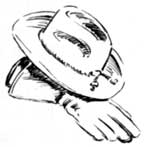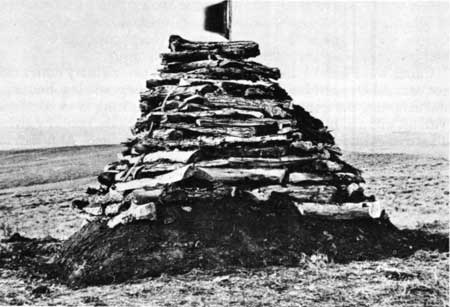|
LITTLE BIGHORN BATTLEFIELD National Monument |
 |

Early view of the Custer Battlefield taken before 1890.
(Courtesy of the National Archives.)
The Tragic Story Released
The Far West landed its precious cargo at Bismarck at 11 p. m., July 5, 1876, and within a few minutes the news of the battle and its details were being given to the world. The most difficult task was to break the news to the families of those who had been killed. Mrs. Custer expressed the feeling of herself and others when she wrote in Boots and Saddles (1885), "This battle wrecked the lives of twenty-six women at Fort Lincoln, and orphaned children of officers and soldiers joined their cry to that of their bereaved mothers."

To send out news of the battle, J. M. Carnahan, the telegraph operator at Bismarck, took his seat at the telegraph key and for 22 hours he hardly moved from his chair. Upon completion of this message, he remained another 60-odd hours at the key without rest or sleep sending newspaper dispatches throughout the country.
News of the shocking disaster was heralded under big headlines by the press of the day. It brought repercussions from many parts of the country. Investigations were demanded as to the causes of the tragedy. Accusations and insinuations concerning the blame for what had happened led from Fort Abraham Lincoln to Washington. President Grant regarded the defeat as a "sacrifice of troops" by Custer. Others condemned Reno and Benteen. Some of the mystery occasioned by the battle on that fateful date in 1876 remains unsolved.
For the surviving troops there was little rest until the Indians so completely victorious on the Little Bighorn, were subdued. As the "hostiles" dispersed, some were pursued and finally dealt a crushing blow in the Battle of Slim Buttes. Others escaped and, with Sitting Bull, took refuge across the international boundary in Canada, until they were induced to return peaceably and take up reservation life which had seemed so distasteful. Except for the Battle of Wounded Knee Creek in 1890, there were no further armed conflicts with the Sioux, who accepted the advance of the frontier settlements.

Capt. Myles W. Keogh and troopers of Company I
were killed here. Photograph taken in 1877.
One year after the battle, during the summer of 1877, Company I, Seventh Cavalry, under the command of Capt. Michael V. Sheridan, returned to the battlefield. The bodies of 11 officers and 2 civilians were exhumed and shipped to the homes of the relatives of the deceased. General Custer's remains were sent to the post cemetery at the United States Military Academy, West Point, N. Y, and reburied October 10, 1877.
The remaining bodies, with the exception of Lieut. John J. Crittenden, were carefully reburied in one large grave on top of Custer Hill, within the enclosure on which a large granite memorial now stands. Lieutenant Crittenden's body, upon request of his relatives, remained buried on the battlefield until 1931, when it was exhumed and buried within the national cemetery grounds.

First Custer memorial constructed in 1879. It was made of cord wood
and filled in the center with horse bones.
(Photograph by L.A.
Huffman.)

|
|
Last Modified: Sat, Sep 28 2002 10:00:00 pm PDT |


